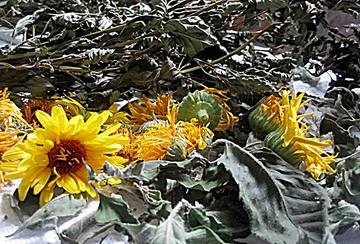
Creams, Lotions and Salves

Creams, lotions and salves contain the same basic ingredients - a hydrosol, an oil or fat and wax - just with different ratios.
Creams are made using a ratio of 1 part water-based ingredients, 3 parts oil-based ones, and 1/2 part wax to ensure their stability. Thick cold creams that remove heavy makeup and protect skin from winter damage are water-free.
The recipe for a lotion calls for a 2:1:0.5 ratio of water-based ingredients, oils, and wax.
Creating a salve is as simple as mixing wax and oil or plant butter in a 1 to 5 ratio.
They all undergo the same manufacturing process. Warm the wax, oil and butter until they melt and combine well, warm the water-based components to the same temperature and blend them into the oil slowly, using a hand blender.
The cream rapidly lightens up and turns fluffy and buttery, like frosting. Once that occurs, add in the essential oils you want, pour the warm cream or salve into a jar, and slightly tighten the lid.
While creams retain their pourable consistency, salves solidify after cooling.
It is recommended to wait 24 hours before use so that the ingredients can blend and balance.

Lozenges, Syrups, Tinctures and Tisanes

Herbal preparations meant to be ingested are typically brewed into tisanes, combined with honey and sugar to make lozenges and syrups, or steeped in alcohol to create tinctures.
A tea without tea leaves or caffeine, brewed for its therapeutic properties, is called a tisane or herbal tea.
Although tisanes have active medicinal ingredients, they are so diluted that they require consumption in large quantities, usually two cups daily, to show any effects.
The only difference between medicinal syrups and culinary syrups is that medicinal ones extract active ingredients by steeping in herbs, which are removed at the end.
Lozenges are medicated toffees prepared with herbal teas instead of water. To soothe a sore throat, use either peppermint or plantago. For stomach upsets, ginger, mint, and cinnamon work well. For a fever, try feverfew or chamomile. For cough, elderberry or balsam fir needles.
Tinctures make use of dry ingredients such as cinnamon sticks, cloves, peppercorns, or citrus peel, and are meant to be used in small quantities, 1 teaspoon at a time.
The main quality that recommends them is their indefinite shelf life.
Herbal preparations are less precise and potent than medication, and they are not meant to serve as a substitute. They may not have targeted rapid action, but they do have a soothing and comforting effect. When the sniffles come around, who doesn't reach for a warm cup of herbal tea with honey?
